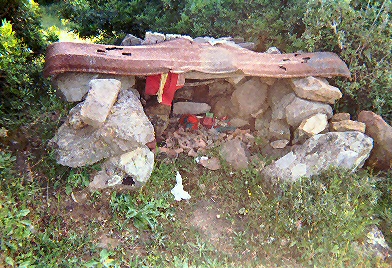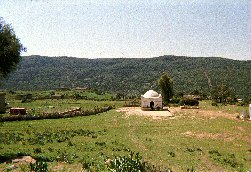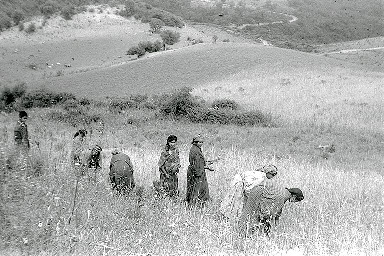Religie en samenleving (1971)




Wim van Binsbergen's webpage on Khumiriyya (N.W. Tunisia), late 18th - mid-20th century
Religie en samenleving (1971) |
|
|
 |
Wim van Binsbergen's webpage on Khumiriyya (N.W. Tunisia), late 18th - mid-20th century |
return to the index page of Historic Berber culture
(c) 2006 Wim van Binsbergen
Wim M.J. van
Binsbergen
RELIGIE EN
SAMENLEVING:
EEN STUDIE OVER HET BERGLAND VAN N.W. TUNESIË
summary prepared June 1980
doktoraalscriptie
Universiteit van Amsterdam, 1971 ix + 326 pp. •limited
mimeograph edition,
revised
English edition in preparation:
Shrines and Ecstasy in the Social Structure of Northwestern Tunisia (to be published in a series of Mediterranean sociological studies edited by C.A.O. van Nieuwenhuijze, published by Brill, Leiden; I hope to complete the revised manuscript by the end of 1980 (sic!)
Based on relatively
short field-work in Northwestern Tunisia in 1968 and 1970, this
study is still one of the very few full-size contributions to the
religious anthropology of rural North Africa. As a contribution
to local ethnography, the study presents a detailed picture of
the various components of popular religion in the area (the
limited scope of formal-Islamic elements; saints, shrines,
cemeteries, and pilgrimage; other manifestations of the sacred as
located in the landscape; ecstasy and religious brotherhoods. On
the basis of a painstaking analysis of the contemporary social
organisation of this rural area (earlier presented in a thesis
entitled ‘Verwantschap en territorialiteit in de Sociale
structuur van het Bergland van Noord-West Tunesie’,
doctoraalscriptie, Universiteit van Amsterdam, 1970, vii + 173
pp., typescript), the distribution of shrines (saints’
tombs) and cemeteries in the area is shown to be intimately
related to a structure of territorial segmentation. Collective
pilgrimage of the members of a local territorial segment stresses
the manifold relations between a segment and the invisible
associated saint, which is the segment’s main symbol and
focus. But whereas the overwhelming majority of visits to saints’
tombs can be explained in this way, there are also forms of
non-collective, individual pilgrimage, which do not reinforce the
local segmentary structure, but instead represent relationships
that cut across segments. These individual pilgrimages, typically
over wider distances than the collective ones governed by
territorial segmentation, are shown to be intimately related to
the marriage pattern and to an emerging structure of social and
economic inequality, both of which are examined in some detail.
Thus a picture emerges of a religiously-structured field of
intra- and inter-segment relationships — a cultic landscape
in which the non-saintly manifestations of the sacred (such as
spirits, threshing-floors and springs) form an integral part. In
so far as segmentation is not only a structure but also a
process, and the contemporary segmentary divisions are the result
of processes of fission and fusion that occurred, in the near
past, a detailed reconstruction of the residential and migratory
history of the area from the early 19th century onwards leads on
to a detailed analysis cf. the creation,, waxing and waning of
the very many major and minor shrines in the area, in close
association with the political and economic vicissitudes of the
vicissitudes of the associated segments. To the historical
picture thus emerging is added an examination of the history of
the Qadiriyya brotherhood over the same period, and its
relationship with major shrines and segments. The contemporary
data on individual membership of this brotherhood (to which close
to 25% of the adult male village population belongs) are analysed
in order to establish the social-structural factors determining
membership. The deprivation thesis (which
views aspirations to religious specialist status and leadership,
especially in a context of ecstatic religion, as springing from
deprivation in the non-religious aspects of life) could not be
corroborated by careful statistical analysis. Instead a
relationship was established between membership of the
brotherhood, and a submerged line of matrilateral descent, in
this otherwise so emphatically patrilineal, Islamicised society.
In the final part of the study the main cultural themes in the
popular religion of the area are examined: the basic concept of
grace (baraka), the
sacred ecology and the interactions between saint and man,
against the background of .social organisation and structures of
production. In a number of appendices, including c. 50 pp. of
condensed statistical analysis, the mainly quantitative data are
presented on which this study is solidly based, despite the
limited field-work period.
As a more theoretical contribution to the anthropology of religion, this study is clearly conceived within the framework of the correspondence theory, which looks for systematic analogies, isomorphisms, and compensatory reversals between religious and non-religious elements in a given society. The shrine, and the associated saint, as a main symbol of a territorial segment is an idea that owes much to Durkheim’s classical analysis in Les formes élémentaires de la vie religieuse (1912). The empirical applicability of this idea should not surprise us, as there is a direct link between Durkheim’s seminal work and Mediterranean religious anthropology, via Robertson Smith’s Religion of the Semites (1889). The thorough examination of non-religious aspects of social organisation, of social-structural determinants of individual religious behaviour, and the historical dimension added to contemporary segmentary and religious structures and actions, make the study into more than just a pious, self-validating restatement of the classic correspondence thesis.
The limited period of field-work, however, made it inevitable
that little insight is offered in the psychological and
interpersonal dynamics of local religiosity. The emphasis in the
study is on religion in local social structure and history, and
even such individual and extended-case data as the author had
available have not been included in the present study (this will
be corrected in the English version now in preparation). Likewise
the analysis of cultural forms, symbolism and myth has not yet
been satisfactorily incorporated into the social-structural and
historical argument. Finally, although the ecological
significance of saint worship is discussed as an aspect of the
cultic landscape, the present study is deficient in that it
explains the distinctions and contradictions in the religious
system largely by reference to social-organizational patterns,
and does not examine such more infrastructural, material
contradictions (especially those between generations, between
sexes, and between local producers and the encroaching world
system) which on the level of production and reproduction exist
in rural North-African society, and which no doubt find
expression, and partial reconciliation, in the religious sphere.
Also these aspects will be dealt with in the rewritten English
version. This
will also offer the opportunity to link this body of data with
such expanding fields of theory as the anthropology of religion
(the theories of pilgrimage, regional cults, and territorial
cults as formulated or stimulated by such authors as V. Turner,
R. Werbner and M Schoffeleers), as have dominated the
sub-discipline in .the decade since this study was written,
June, 1980
Related
publications (up to 1980)
1971 a
‘Saints of the Atlas: Ernest Gellner’,
Cahiers de Arts et Traditions populaires, 4,
1971, pp. 203-211.
b ‘Muziek en dans in het Atlasgebergte’, Muziek en Volkenkunde, Jan.-May 1971, no. 109-113.
1976
‘Shrines, Cults and Society in North and Central Africa: A
Comparative Analysis’, paper read at the Association of
Social Anthropologists of Great .Britain and the Commonwealth
(ASA), Manchester, mimeo.
1980
‘Popular and formal Islam, and supra-local relations: The
highlands of Northwestern Tunisia, 1800-1970’, Middle
Eastern Studies, 16, 1: 71-91.
return to the index page of Historic Berber culture
The illustrations in the heading of this
webpage:
|
|||
 |